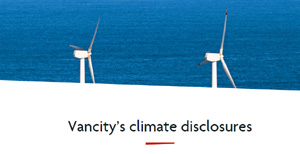Saturday June 26, 2021 | VANCOUVER, BC
by Jalen C Codrington | Island Social Trends | Editor: Mary P Brooke
Back in January, Vancity committed to achieving net-zero emissions across its lending portfolio by 2040. This week, the credit union disclosed the GHG emissions generated from its loans and investments in a climate emissions report in a news release on June 24.
According to the federal government, Canada’s total GHG emissions in 2019 were comprised of 730 megatonnes of carbon dioxide equivalent (Mt CO2 eq). In the same year, the fossil fuel and transport sectors were the largest GHG emitters in Canada. Together, they accounted for 52% of total emissions. Vancity says they do not directly lend to the fossil fuel sector.
Coming behind oil and transportation, commercial and residential buildings tend to be the third highest-emitting sector. Building emissions come from a combination of the day-to-day energy use; and the carbon generated through manufacturing building materials, transporting materials to construction sites, and the actual construction process.
Residential mortgages, the largest line of business for Vancity, generate 2.4 tonnes of carbon dioxide for every dollar invested. Vancity has just under $13 billion invested in residential mortgages, resulting in 31,162 tonnes of emissions per year.
“Tackling the climate crisis requires an urgent system-wide response, and financial institutions have to take ambitious action – even if that means shifting how we all do business. Credible climate accounting and disclosure are at the heart of the necessary shift,” said Christine Bergeron, Vancity President and CEO.
Some emissions data was unavailable. For instance, Vancity does not have comprehensive tracking for all consumer loans, some of which are likely used to purchase vehicles.
The release of this data was voluntary, but Bergeron has called for a more standardized and transparent approach to measuring climate risk across the financial sector.
“Vancity’s disclosure is voluntary, and we’ll continue to report out every year, but Canada’s financial system needs a standardized approach to climate risk metrics if we’re going to be able to understand the broader risks posed by the climate crisis,” said Bergeron.
Climate initiatives of other financial institutions:
- TD – In 2010, TD became the first North American bank to achieve carbon-neutral status in their operations. They have also released a report on their social and environmental credit risk (no date). TD has a climate action plan and maintains the TD Friends of the Environment Foundation.
- CIBC – In 2019, CIBC released a climate change report. They have pledged to reduce their emissions by 20% by 2026 and support $150 billion in sustainable financing by 2027.
- Scotiabank – Scotiabank has pledged to mobilize $100 billion to reduce the impacts of climate change by 2025. As of 2020, they’ve raised $28 billion.
- RBC – RBC has promised to invest $500 billion in sustainable finance by 2025. In addition, RBC has committed to net-zero emissions in lending by 2050.
- BMO – BMO has set a target to reduce operational greenhouse gas emissions by 30% by 2030, and net-zero emissions in their lending by 2050.
- Coast Capital Savings – Coast Capital has become a B Corporation as part of a commitment to meet the highest standards of overall social and environmental performance.







